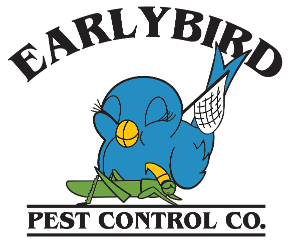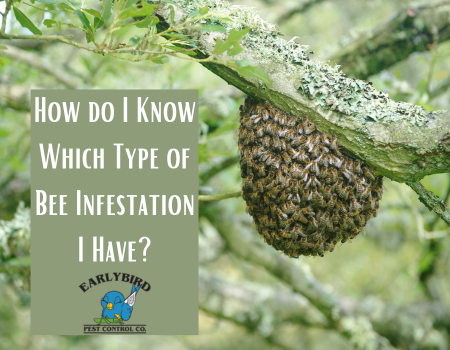Encountering a bee infestation can be a buzzing concern for homeowners, but understanding the type of bee present is crucial for effective management. Different bee species exhibit distinct behaviors, nesting habits, and potential risks. This article aims to help you identify and differentiate between common bee infestations, enabling you to make informed decisions about appropriate actions and, if necessary, seek professional assistance to ensure you remove your bee infestation safely and effectively.
How to Identify the Type of Bee Infestation You Have
Appearance:
Honey Bees:
- Generally plump and hairy.
- Varied colors, often with black and yellow stripes.
- Characterized by a rounder and fuzzier appearance.
Bumblebees:
- Robust and hairy bodies.
- Typically larger than honey bees.
- Distinctive black and yellow markings.
Carpenter Bees:
- They look like bumblebees, but are shiny, and their abdomen is hairless.
- Can be identified by their solitary behavior.
Nesting Habits:
Honey Bees:
- Construct hives in sheltered locations, such as tree hollows or man-made structures.
- Hives consist of combs made of beeswax.
Bumblebees:
- Build nests close to the ground, often in abandoned rodent burrows or other cavities.
- Nests are small, with a few hundred bees.
Carpenter Bees:
- Create tunnels in wood, including wooden structures or furniture.
- Nesting sites often exhibit small, perfectly round holes.
Behavior:
Honey Bees:
- Generally docile and not easily provoked.
- Will defend their hive if they perceive a threat.
Bumblebees:
- Typically non-aggressive, and only the female bumblebees can sting.
- Will defend their nest if threatened.
Carpenter Bees:
- Male carpenter bees are territorial but cannot sting.
- Female carpenter bees can sting but are less aggressive.
Activity Patterns:
Honey Bees:
- Active year-round in warmer climates.
- More active during spring and summer.
Bumblebees:
- Seasonal, with colonies thriving in late spring and summer.
- Nests decline in activity during the fall.
Carpenter Bees:
- Active during spring and summer.
- More noticeable when nesting activities are at their peak.
Location of Nest:
Honey Bees:
- Often found in tree hollows, wall voids, or attic spaces.
- Colonies can grow large and may be noticeable due to increased bee activity.
Bumblebees:
- Nests are typically close to the ground, often in abandoned rodent burrows or under piles of debris.
- Nests are smaller in size compared to honey bee hives.
Carpenter Bees:
- Create tunnels in wooden structures, including eaves, decks, or wooden furniture.
- Nests are characterized by perfectly round holes.
Buzzing Sounds and Flight Patterns:
Honey Bees:
- Emit a steady, constant hum when active.
- Flight patterns are purposeful and relatively straight.
Bumblebees:
- Produce a louder buzzing sound compared to honey bees.
- Flight patterns are more erratic and may involve hovering near flowers.
Carpenter Bees:
- Produce a loud buzzing sound, especially near nesting sites.
- Flight patterns can include hovering and darting motions.
Pollination Behavior:
Honey Bees:
- Highly efficient pollinators with specialized pollen baskets on their hind legs.
- Play a crucial role in pollinating crops and flowers.
Bumblebees:
- Effective pollinators with a unique ability to “buzz pollinate” certain flowers.
- Essential for the pollination of certain crops and wildflowers.
Carpenter Bees:
- Also contribute to pollination, although less efficient than honey and bumblebees.
- May be observed visiting flowers for nectar.
Visual Inspection of Nest:
Honey Bees:
- Hives have a hexagonal cell structure made of beeswax.
- The entrance may have numerous bees coming and going.
Bumblebees:
- Nests are small and made of grass, leaves, and other materials.
- The entrance may be inconspicuous, and the nest is often hidden.
Carpenter Bees:
- Tunnels in wood are easily visible, especially around eaves or wooden structures.
- Sawdust-like material may be present near the entrance.
Response to Disturbance:
Honey Bees:
- Release a pheromone when threatened, signaling other bees to defend the hive.
- Can be aggressive when the hive is disturbed.
Bumblebees:
- Tend to be less aggressive but will defend their nest if provoked.
- May become more defensive if their nest is disturbed repeatedly.
Carpenter Bees:
- Male carpenter bees may display territorial behavior but cannot sting.
- Female carpenter bees can sting but are generally less aggressive than honey bees.
A comprehensive understanding of the characteristics mentioned above will empower homeowners to confidently identify the type of bee infestation they are dealing with. It is important to approach bee infestations with respect for the vital role these insects play in ecosystems. If a bee infestation poses a threat or becomes a nuisance, seeking professional assistance from pest control experts experienced in bee removal is recommended. Professional help ensures that the bee infestation is managed with minimal harm to both humans and the essential pollinators.


Recent Comments